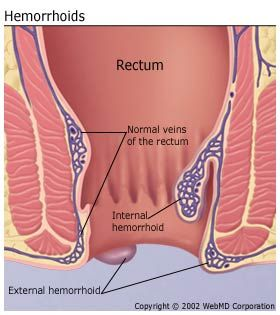Hemorrhoids are usually caused by increased pressure due to pregnancy, being overweight, or straining during bowel movements. By midlife, hemorrhoids often become an ongoing complaint. By age 50, about half the population has experienced one or more of the classic symptoms, which include rectal pain, itching, bleeding, and possibly prolapse (hemorrhoids that protrude through the anal canal). Although hemorrhoids are rarely dangerous, they can be a recurrent and painful intrusion. Fortunately, there's a lot we can do about hemorrhoids.
What are hemorrhoids?
Hemorrhoids are swollen, inflamed veins around your anus or the lower part of your rectum. There are two types:
- External hemorrhoids, which form under the skin around your anus
- Internal hemorrhoids, which form in the lining of your anus and lower rectum
What causes hemorrhoids?
Hemorrhoids happen when there is too much pressure on the veins around the anus. This can be caused by:
- Straining during bowel movements
- Sitting on the toilet for long periods of time
- Chronic constipation or diarrhea
- A low-fiber diet
- Weakening of the supporting tissues in your anus and rectum. This can happen with aging and pregnancy.
- Frequently lifting heavy objects
What are the symptoms of hemorrhoids?
The symptoms of hemorrhoids depend on which type you have:
With external hemorrhoids, you may have:
Anal itching
One or more hard, tender lumps near your anus
Anal pain, especially when sitting
Too much straining, rubbing, or cleaning around your anus may make your symptoms worse. For many people, the symptoms of external hemorrhoids go away within a few days.
With internal hemorrhoids, you may have:
Bleeding from your rectum - you would see bright red blood in your stool, on toilet paper, or in the toilet bowl after a bowel movement
Prolapse, which is a hemorrhoid that has fallen through your anal opening
Internal hemorrhoids are usually not painful unless they are prolapsed. Prolapsed internal hemorrhoids may cause pain and discomfort.
How can I treat hemorrhoids at home?
You can most often treat your hemorrhoids at home by:
Eating foods that are high in fiber
Taking a stool softener or a fiber supplement
Drinking enough fluids every day
Not straining during bowel movements
Not sitting on the toilet for long periods of time
Taking over-the-counter pain relievers
Taking warm baths several times a day to help relieve pain. This could be a regular bath or a sitz bath. With a sitz bath, you use a special plastic tub that allows you to sit in a few inches of warm water.
Using over-the-counter hemorrhoid creams, ointments, or suppositories to relieve mild pain, swelling, and itching of external hemorrhoids
What are the treatments for hemorrhoids?
If at-home treatments for hemorrhoids don't help you, you may need a medical procedure. There are several different procedures that your provider can do in the office. These procedures use different techniques to cause scar tissue to form in the hemorrhoids. This cuts off the blood supply, which usually shrinks the hemorrhoids. In severe cases, you may need surgery.
Post time: Jul-26-2022

